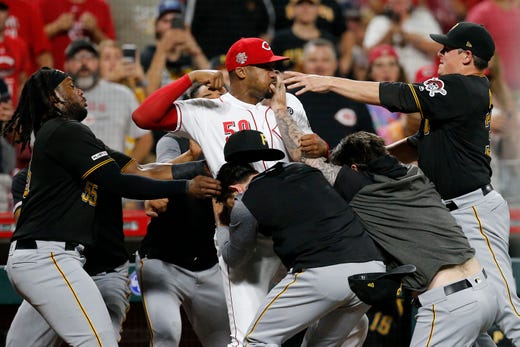Only slight disparity between two viral baseball brawls

By DERON SNYDER (as published in The Washington Times)
Serious question: What’s the difference between the Reds-Pirates ninth-inning brawl Tuesday, and the June 15 brawl between adults at a youth baseball game in Colorado?
Give it some thought.
I suppose money is the first thing that comes to mind. Participants in the MLB brouhaha rake six-, seven- or eight-figure annual salaries for their time. Combatants in the latter incident were mere spectators, parents and/or coaches whose livelihoods don’t rest on the exploits of 7-year-old players.
The level of dedication is another easy distinction.
As per usual when benches clear in the majors, the vast majority of uniformed personnel Tuesday were in peacemaker mode. For every player who charged – Cincinnati’s Amir Garrett and Yasiel Puig, in particular – roughly 5.5 players tried to hold them back.
Conversely, video of the fracas in Lakewood shows more than a dozen folks throwing punches with bad intentions, relentlessly beating and tackling one another. Multiple people were injured, including one who reportedly suffered facial and back injuries and several broken ribs.
But even with the dissimilarities in paychecks and haymakers, the melees have plenty in common.
Both occurred during a baseball game. Both involved adults who were overwhelmed by anger. And both set a poor example for the children who were watching.
“It’s not in the game for something like that to happen,” Garrett told reporters, referring to Tuesday night, when he charged the Pirates’ dugout and threw punches at Pittsburgh starter Trevor Williams. “Sometimes you let emotions get the best of you. I don’t condone that. I don’t like for kids to see that in the baseball environment.”
A natural follow-up: Exactly what environment IS good for kids to see that?
Last week, my colleague Adam Zielonka wrote that researchers consider bad sportsmanship, rude behavior and outright violence among adults at youth sporting events to be a national epidemic, a crisis that sends the wrong message to child athletes and drives away referees in droves.
Scenes like the uproar in Cincinnati don’t help matters. Especially when players aren’t mature enough to let it go once tempers subside.
“I wouldn’t be surprised if it sparks up again,” Pirates starter Joe Musgrove told reporters. “Who knows what’s going to happen down the line, but we definitely expect something to happen at some point. We’ll be ready for it.”
Ready for what, UFC 241?
Some observers are inclined to write off baseball brawls as no big deal, just a boys-will-be-boys kind of thing … even though the “boys” often are grown men. If that’s true, we’ll never see an end to adults behaving badly, whether it’s on major-league diamonds or an elementary school field.
Young witnesses, at least some of them, eventually grow to become adult perpetrators, thus continuing a vicious cycle. They’ll commit similar acts and offer the same, tired excuses they heard in childhood from elders.
“Today was an example of us standing our ground for what we think is right,” Cincinnati first baseman Joey Votto told reporters. “At some point, a group of players has to do that.”
I can hear quarrelsome adults in Lakewood making the same argument: At some point, we had to stand up for our kids.
With reasoning like that, everything afterward is relative.
The Coloradoans aren’t paid professionals, but they still have their pride. They were much more committed to inflicting actual damage on foes, but Garret and Puig weren’t handing out flower bouquets, either. Youth games aren’t televised nightly like major-league games, but that doesn’t matter since both brawls became national news.
Thirteen-year-old umpire Josh Cordova, who was behind the plate that day in Lakewood, told a Denver TV station that he admonished spectators about using foul language moments before the free-for-all erupted. He said chirping from coaches and spectators for both teams led to a formal warning after “an old man dropped the f-bomb on the sidelines.
“I shouldn’t have to tell a grown man how to act around little kids,” Cordova told KUSA-TV.
That goes for big leaguers, too.
Not to condone violence in other sports, but baseball isn’t hockey, where fighting is ingrained within the fabric. It’s not football, where opponents literally hit each other on every play. It’s not basketball, where altercations are sparked by proximity and physical contact.
Baseball is governed by fuzzy, unwritten rules. There are criteria for hitting players who flip their bats or admire their homers too long. There are decrees on hitting players whose pitcher previously hit a player for reasons deemed unrelated to control. And there are guidelines for charging the mound, though Garret might’ve set a precedent by charging an entire dugout.
But regardless of the sport, the bottom line – and the effect on society – remains the same:
There’s less difference than you think between Tuesday’s brawl and the brawl on June 15.
— Brooklyn-born and Howard-educated, Deron Snyder writes his award-winning column for The Washington Times on Tuesdays and Thursdays. Follow him on Twitter @DeronSnyder.
 Follow
Follow
